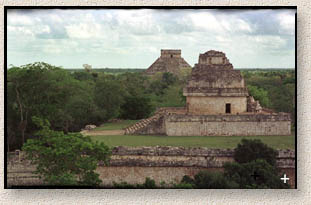Maya
The Maya are probably the best-known of the classical civilizations of Mesoamerica. Originating in the Yucatan around 2600 B.C., they rose to prominence around A.D. 250 in present-day southern Mexico, Guatemala, western Honduras, El Salvador, and northern Belize.
 Building on the inherited
inventions and ideas of earlier civilizations such as the Olmec, the Maya
developed astronomy, calendrical systems and hieroglyphic writing. The Maya were
noted as well for elaborate and highly decorated ceremonial architecture,
including temple-pyramids, palaces and observatories, all built without metal
tools. They were also skilled farmers, clearing large sections of tropical rain
forest and, where groundwater was scarce, building sizeable underground
reservoirs for the storage of rainwater. The Maya were equally skilled as
weavers and potters, and cleared routes through jungles and swamps to foster
extensive trade networks with distant peoples.
Building on the inherited
inventions and ideas of earlier civilizations such as the Olmec, the Maya
developed astronomy, calendrical systems and hieroglyphic writing. The Maya were
noted as well for elaborate and highly decorated ceremonial architecture,
including temple-pyramids, palaces and observatories, all built without metal
tools. They were also skilled farmers, clearing large sections of tropical rain
forest and, where groundwater was scarce, building sizeable underground
reservoirs for the storage of rainwater. The Maya were equally skilled as
weavers and potters, and cleared routes through jungles and swamps to foster
extensive trade networks with distant peoples.
Many people believe that the ancestors of the Maya crossed the Bering Strait at least 20,000 years ago. They were nomadic hunter-gatherers. Evidence of settled habitation in Mexico is found in the Archaic period 5000-1500 BC - corn cultivation, basic pottery and stone tools.
The first true civilization was established with the rise of the Olmecs in the Pre-Classic period 1500 BC -300 AD. The Olmecs settled on the Gulf Coast, and little is known about them.
They are regarded as the inventors of many aspects of Meso-American cultures including the first calendar and hieroglyphic writing in the Western hemisphere. Archeologists have not settled the relationship between the Olmecs and the Maya, and it is a mystery whether the Maya were their descendants, trading partners, or had another relationship.
It is agreed that the Maya developed a complex calendar and the most elaborate form of hieroglyphics in America, both based on the Olmec's versions.
Most artistic and cultural achievement came about during the Classic period 300 - 900 AD. The Maya developed a complex, hierarchical society divided into classes and professions. Centralized governments, headed by a king, ruled territories with clearly defined boundaries. These borders changed as the various states lost and gained control over territory. Mayan centers flourished in Mexico, Guatemala, Belize, Honduras, and El Salvador. The major cities of the Classic period were Tikal (Guatemala), Palenque and Yaxchilan (Chiapas, Mexico), Copán and Quirigua (Honduras). For most of this period, the majority of the Maya population lived in the central lowlands of Mexico and Belize.
The Northern Yucatan (where present day Cancun is located) was sparsely populated for most of the Classic period with only a few cities such as Dzibilchaltún (near Mérida) and Xpuhil, Becán and Chicanná (near Chetumal). During the 9th century the population centers of the central lowlands declined significantly. This decline was very rapid and is attributed to famine, drought, breakdowns in trade, and political fragmentation. Fragmentation from large states into smaller city-states focused resources on rivalries between cities including not just wars, but competitions of architecture and art between rival cities. As the cities in the lowlands declined, urban centers sprung up in the Northern Yucatan, including Uxmal (near Mérida).
Anthropologists used to contrast the "peaceful" Maya with the bloodthirsty Aztecs of central Mexico. Although human sacrifice was not as important to the Maya as to the Aztec, blood sacrifice played a major role in their religion. Individuals offered up their blood, but not necessarily their lives, to the gods through painful methods using sharp instruments such as sting-ray spines or performed ritualistic self mutilation. It is probable that people of all classes shed their blood during religious rites. The king's blood sacrifice was the most valuable and took place more frequently. The Maya were warlike and raided their neighbors for land, citizens, and captives. Some captives were subjected to the double sacrifice where the victims heart was torn out for the sun and head cut off to pour blood out for the earth.
The Mayan civilization was the height of pre-Columbian culture. They made significant discoveries in science, including the use of the zero in mathematics. Their writing was the only in America capable of expressing all types of thought. Glyphs either represent syllables or whole concepts and were written on long strips of paper or carved and painted on stone. They are arranged to be red from left to right and top to bottom in pairs of columns. The Mayan calendar begins around 3114 BC, before Maya culture existed, and could measure time well into the future. They wrote detailed histories and used their calendar to predict the future and astrological events. Fray Diego de Landa, second bishop of the Yucatan ordered a mass destruction of Mayan books in 1562 and only three survived.
After the Classic period, the Maya migrated to the Yucatan peninsula. There they developed their own character, although their accomplishments and artwork are not considered as impressive as the Classic Maya.
Chichen Itza (near Valladolid), Uxmal (near Merida) and Mayapan (west of Chichen Itza) were the three most important cities during the Post Classic period. They lived in relative peace from around 1000 - 1100 AD when Mayapan overthrew the confederation and ruled for over 200 years. In 1441 the Maya who had previously ruled Uxmal destroyed the city of Mayapan and founded a new city at Mani. Wars were fought between rival Mayan groups over the territory until the region was conquered by the Spanish.